When choosing the right material for the construction of the house, the final cost of the materials necessary for the erection of the building plays an important role. Run on the house calculator, presented on the site, is capable of a couple of seconds.
In order to calculate materials and the approximate cost of construction, it is required to enter the initial data of the future object into special forms, select the required indicators from the drop-down menu and start the calculation process.
This article details the main characteristics of the house, which are taken into account when assessing the cost of building a house. Thus, the interactive calculator is used to calculate the number and parameters for the construction of wall structures for residential and non-residential premises.
When calculating, it is possible to take into account pediments, window and door openings. The calculator provides information on the required volume of basic materials - such as sand-cement mortar, masonry net and their cost.
The values that the calculator requires to specify are not always familiar to an inexperienced builder, to fill this gap, and this article is intended. Below is a description of the main materials used in the construction and their characteristics.
Foam concrete: basic information
Blocks of foam concrete - one of the types of porous porous concrete, which, in addition to water, contains cement, sand and foaming agents. Frother is a key component of the concrete mix for porous blocks, because thanks to it the material acquires air pores and becomes light and "breathable".
The structure of such concrete is called cellular because it contains a large number of closed air pores, uniformly distributed throughout the volume of the material.
Foam concrete is one of the most popular materials for the construction of buildings. With its help, the main work is carried out:
- block erection of external walls,
- block erection of internal walls and ceilings,
- use as a heat-insulating material,
- application for the purpose of soundproofing from external noises.
In order to use the calculator, some information will be required. In particular, the calculation of foam blocks at home calculator is able to produce with the following input data:
- block dimensions: length, height, width
- the density of the material (D)
- perimeter of the building (length of all walls)
- height of walls at corners
- wall thickness
- layer thickness of the mixing mixture
- periodicity of laying masonry net
- cost of a foam block per piece
![]()
Dimensions of foam concrete
Dimensions of blocks from foam concrete depend on the approved project and the customer's wishes. When choosing the required size, it is taken into account what type of wall will be erected with their help: a monolithic, internal partition.
Depending on the potential loads on the wall, the required density and functions of the wall, the size of the foam block is determined. The length in this question is an indicator of the secondary, but the width is the main one. It is the thickness of the wall that affects the ability of the building to withstand loads and perform heat and sound insulation functions.
The standard size of foam concrete blocks is 200x300x600 mm (thickness x height x length). Blocks of this size are used for exterior walls. Foam concrete with a wall thickness of 100 mm is chosen for the construction of internal walls and is called the semi-block.
The length of the block in 600 mm is regulated by GOST 21520-89. In most cases, foam concrete is produced just this length.
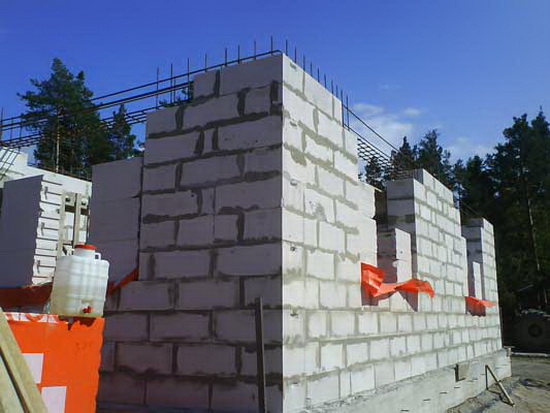
Density of material
The strength of foam concrete depends on its density. The density of the material is represented by several groups:
- D300-D500
- D600-D1000
- D1000-D1200
Group D300-D500 belongs to the category of heat-insulating materials and is used for walls already erected from other materials.
Group D600-D1000 is included in the category of heat-insulating and structural materials. This means that these concrete can warm the walls of buildings, and also build wall structures for single and double-storey houses, as well as for building walls inside the house.
Concretes D1000-D1200 are used for the erection of exterior walls of houses with a floor from one to four floors. Such materials are the most durable and resistant to mechanical influences.
The quality of the foam concrete has a huge influence on the monumentality of the final building. In view of its low cost and great popularity, it is produced by enterprises - large and small, artisanal.
Because of the desire to save in the composition of the concrete mixture includes hazardous to human health components, choose cheap low-quality components and change the composition of concrete. As a result, material that is unstable to mechanical influences, which is unusable for load-bearing structures, even with the D1200 marking, is obtained.
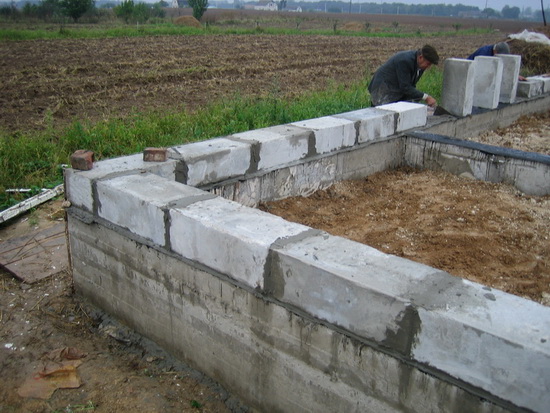
Perimeter of building
To find out the perimeter of the future building, you need to use the scheme of the future project. When calculating it is necessary to know the perimeter of the outer walls and internal ones.
The outer perimeter is obtained by adding the length of all the exterior walls of the building.
The inner perimeter is made up of the length of the walls that divide the house into rooms or participate in other interior solutions.
During construction, it is possible to use the same concrete for indoor and outdoor construction, but this significantly increases the cost of the project. Therefore, for exterior walls, a foam concrete labeled D600-D1200 is usually used, and for indoor walls, blocks and semi-blocks of the D300-D600 brand are used.
Wall height
This parameter is determined strictly by the values that are provided by the project of the house. Builders recommend buying foam concrete with a margin of 10%, as during transportation and processing it takes place a battle of material.
Wall Thickness
When calculating the thickness of the house, you should again refer to the project, these data are usually laid at the design stage. It should be borne in mind that the thickness factor is taken into account the thickness of the masonry seam.
Milling mixture thickness
During construction, horizontal seams and butt joints, made from typical solutions, usually have a thickness of not more than 15 mm, but not less than 6 mm. It should be borne in mind that the seam thickness of more than 20 mm greatly reduces the soundproofing qualities of the foam concrete.
The periodicity of using the masonry grid
The number of masonry mesh is measured in meters. It is used to further strengthen the layer of foam blocks, increasing the monolithic quality of the house and the overall strength of the structure. Periodicity depends on the type of future home, the complexity of its design and the type of foam blocks.
Cost of a foam block
The cost of the foam block depends on its thickness and density, as well as on what materials were used in its production. On average, the price of a foam block of standard sizes is from 80 rubles per piece.
Thus, in order to calculate the foam blocks at home, the calculator must take into account all of the above data. Without them, it is not possible to determine the amount of materials and the total cost of the project. Most of the data can be obtained from the project of the future building.
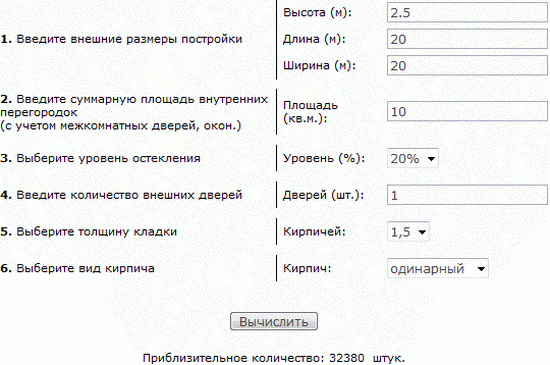
-
An interactive calculator for the construction of a house made from aerated concrete is necessary for making calculations of construction materials that will be required for the construction of real estate objects - houses, baths, sheds, garages, utility rooms. AT... -
Twenty years ago it was impossible to find a private bathhouse built of any materials, except wood. However, with the appearance on the market of such material as foam concrete, baths and ...
The foam blocks are a well-known and well-known building material used for the erection of wall structures. The material is a lightweight concrete with a porous structure. Part...
Most buyers who decide to choose foam blocks for construction face the problem of calculating their number. This is not surprising: each specific construction project will have its own characteristics, which must be taken into account when calculating the number of foam blocks. Otherwise, the developer risks remaining with the material on the site, or buying at least one cube of the foam block to complete the construction. All this entails additional transportation costs, which can be easily avoided.
- Use our special calculator. The downside is that the calculator calculates only one size and does not take into account the technological holes. This method is applicable for an approximate calculation and determination of the material cost.
- Contact our managers by describing the dimensions of your building or by sending a finished project. This method will be the most accurate. The calculation will be made by a professional builder who will take into account all the nuances and will be able to calculate the foam block with a minimum error.
- Independently determine how many foam blocks you need with the help of an ordinary calculator. We will describe this method in more detail ...
Determine the size of the building
So, first we have to decide what dimensions the building will have. For example, take arbitrary values for a one-story structure of a rectangular shape. Let us also assume that the height of the walls is the same everywhere:
- dimensions of external bearing walls (7 mx 10 m)
- total length of partitions (13 m)
- building height (3 m)
Wall thickness:
- external walls (0.3 m)
- interior partitions (0.1 m)
Dimensions of technological holes
- windows 5 pcs. (1.8 mx 1.2 m)
- entrance door 1piece. (2 m. X 0.9 m)
- interior doors 3 pcs. (2 m x 0.8 m)
Determine the size of blocks
Since the thickness of the outer walls was taken to be 30 cm, the foam block must necessarily have one of the faces of this length. The most popular among the foam concrete blocks is the size 200x300x600. Sometimes it is replaced by a size of 250x300x600, but, because of the greater weight, builders prefer the first option.
If you decide to use gas silicate blocks, the choice is significantly extended. For this material, the dimensional range is much more diverse, however, the essence remains unchanged: one of the faces should be equal to the thickness of the wall.
Adhering to the most popular solution, we suggest using the size of the foam block 200x300x600 for our calculation. Nevertheless, in a similar way you can make a calculation for absolutely any size.
Calculation of the number of foam blocks for load-bearing walls
In order to find out how many foam blocks you need, first calculate the perimeter of the box of the future building (7 m + 10 m.) X 2 = 34 m. Then multiply the perimeter by the height of the walls (3 m.) And get the total area of the box walls without accounting technological holes 34 m. x 3 m. = 102 m 2
At this stage it is necessary to determine the number of all technical holes that will be in the outer walls of the building. The more you will know the size of future holes, the more accurate the final calculation will be.
For a better understanding, we will simplify the task a little and take into account only the windows and one entrance door. Suppose we have:
- 5 windows (1.8 mx 1.2 m)
- 1 entrance door (2 m x 0.9 m)
We first calculate the area for one window (1.8 mx 1.2 m = 2.16 m 2), and then for all five windows (2.16 m2 x 5 = 10.8 m 2). Add to the result obtained the door area (10.8 m 2 + 1.8 m 2 = 12.6 m 2) and get the area of all the holes in the outer walls of the building.
As you guessed it, we only need to subtract the total area of the holes from the wall area, which we calculated earlier (102 m 2 - 12.6 m 2 = 89.4 m 2). So we found the area of the outer bearing walls without all the technical holes (in our case it's only the windows and the front door)
Finally we proceed to calculate the volume directly. Recall that for external walls we have chosen the size of the foam block 200x300x600, the amount of which we now need to calculate. Our goal at this stage is to calculate the area of the block itself, but not all, but only that side that will be external. Considering that we laid a thickness of 300 mm, so the area of the outer side will be a product of 200 mm. and 600 mm. (0.2 mx x 0.6 m = 0.12 m 2).
We have come to the calculation of the number of blocks necessary for the construction of external walls. To do this, it is necessary to divide the area of walls without technological holes into the area of that side of the foam block, which we just counted (89.4 m 2 / 0.12 m 2 = 745 pcs).
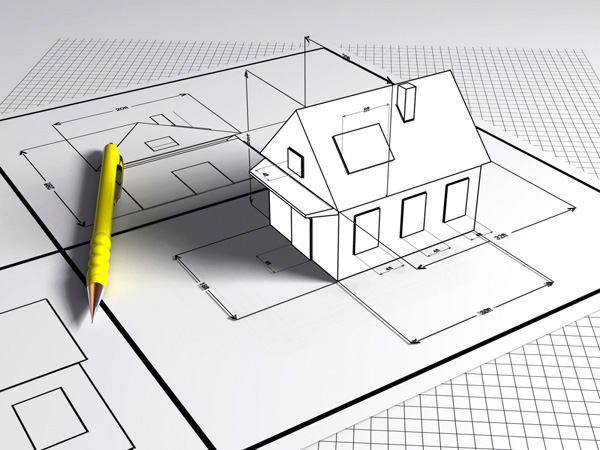
How many foam blocks in the cube (200h300h600)
Sometimes it is much more convenient to measure the number of blocks in cubic meters. This is especially true if the required volume for your construction is large enough.
So, in order to determine how many foam blocks 300 200 600 in 1m 3 you need to perform the following calculations: alternately divide the unit by the length of each side of the block in meters. Let's give an example, 1 / 0.2 m / 0.3 m / 0.6 m. The resulting value is rounded to the nearest hundredth and we get 27.78 pcs. This rule applies to all blocks that have smooth faces. For all other types of foam blocks, the calculation will be slightly different.
For greater clarity, we define how many foam blocks 250 300 600 in a cube:
Similar to the past action, divide the unit by the length of all three faces of the block (1 / 0.25 m / 0.3 m / 0.6 m = 22.22 pcs.)
Now it is not difficult for us to calculate the volume of foam blocks for our walls. To do this, simply divide the received quantity (745 pieces) by the quantity in 1 m 3 of the foam block of our size (27.78 pieces). As a result, we get 26.82 m 3 with rounding up.
Calculation of the number of foam blocks for partitions
Recall that the thickness of the interior walls, we took for 0.1 m. For our demonstration calculation, we take for the partitions a block with a size of 100x300x600. Thus, by performing the same calculation for the partitioning blocks, we obtained:
- total area of interior walls - 39 m 2
- total area of those. holes in the partitions - 4.8 m 2
- area without regard to those. holes - 34.2 m 2
- the area of the partition wall (0,3 x 0,6) - 0,18 m 2
- number of units - 34.2 m 2 / 0.18 m 2 = 190 pcs. or 3.42 m 3
Final calculation of foam blocks
Due to the fact that the foam blocks are easy to saw, with the correct calculation after construction, there is rarely any unused material. Nevertheless, we should add about 2% of the percentage to the result, because some of the blocks may just be damaged by delivery or unloading, and any manufacturer has the right to pledge such a percentage of the battle.
In the end, we get:
- size 200x300x600 - 26.82 m 3 + 2% = 27.36 m 3
- size 100x300x600 - 3.42 m 3 + 2% = 3.49 m 3
How many foam blocks per square meter
Sometimes, in order to calculate the required number of masonry mixtures or plaster, it is necessary to determine the number of foam blocks in a square meter of the wall. This calculation will not be difficult, if we recall how the area of the block was calculated.
For example, we define the number of blocks in 1m2 of the wall of our building. As you remember, we assumed the thickness of the outer wall to be 0.3 m. Thus, the two remaining faces will serve as the sides of the rectangle (this rectangle will be the outer side of the block), the area of which we need to calculate. Calculating the product (0.2 m x 0.6 m), we obtain 0.12 m 2. Now it remains only to divide 1 square meter of the wall by 0.12 m 2 (1 / 0.12 = 8.33 pcs.). Now we know the number of foam blocks in a square meter of the wall and we can easily calculate the consumption of any dry mixture.
In conclusion, it should be said that the most rational is to entrust the calculation of the number of foam blocks to the specialists of ProffStroy company. Using this free service, you can significantly reduce the cost of purchasing building materials.
Calculation of the number of foam blocks for building a house is necessary to determine the construction budget. We can not even approximately know the cost of construction without accurate information on the number and total cost of the foam blocks for building the walls of the house.
What is a foam block and where it is used
In its pure form, the foam block is a building material made of foam concrete. Foam concrete is produced by foaming a concrete solution with special additives with the help of certain equipment.
Get foam concrete, using two technologies. The simplest of them involves an intensive mixing of ingredients with the involvement of air in their composition, which causes foaming. For quality foaming, a large amount of water is needed. But then this leads to a loss of strength of the final product. To avoid loss of strength, a plasticizer is introduced into the solution, which restores the strength properties of the concrete.
The second technology is more long-term and requires more costs, but the products receive higher strength indicators. In the conditions of industrial production, this method is used.
Foam concrete has found its application in low-rise construction and competes on an equal footing with standard brick, both at cost and in terms of technical and operational indicators.
Calculation of the number of foam blocks
Any calculations given by us can have some errors and inaccuracies. Exact calculation is usually performed by the project organization or the company that oversees the project. In any existing, even the most accurate project, there are many nuances. They are due to the brand of foam block, the thickness of the seam, the number of piers and partitions, the number of windows and doors. But this even very approximate calculation will help us to know the approximate estimate for the construction of a house or cottage.
On sale you can find blocks with slightly different sizes - 200h250h600 mm for insulation of monolithic buildings and 400x250x600 for laying strong walls, first floors and bearing walls of private houses.
Blocks for interior partitions and non-bearing walls are made of lightweight foam concrete. They meet all standard standards for noise insulation, thermal insulation, fire protection standards, with a thickness of 100 mm they are resistant to fire for four hours. Their standard dimensions are 100x300x600 mm and they weigh half as much as the wall foam blocks.
The weight of one unit of the barrier foam block, depending on the brand, is given in the table:
Prostenochnye foam blocks, usually made of cement grade D1000, and for bathrooms and the outer perimeter, their size can be 75h250h600 mm.
It's easy to answer the question how much a foam block contains in 1 m3 is simply impossible, since there are a lot of manufacturers and each or almost every foam foam unit is of different size. Therefore, below, we have resulted tables in which the amount of material per cubic meter has already been calculated. then you can do it yourself, if you want to practice in geometry for grade 4.
Proceeding from the classical, standard size of the foam block in 600h300h200 mm, we learn the volume of one block, then 1 m3 will be divided into the number obtained. As a result, we get the number 33. This is the number of a standard-size foam block in a cubic meter. But to simplify yourself and your life, we brought up the tables with all possible sizes of foam blocks.
Methods for calculating the number of foam blocks
Method 1 - by series
Calculate the amount of foam block can only be an example. We already have absolutely all the data, except the data on our construction. To simplify the task, let's take a construction of 6x5x2.8 m from the standard 200x300x600 mm block. Then we need:
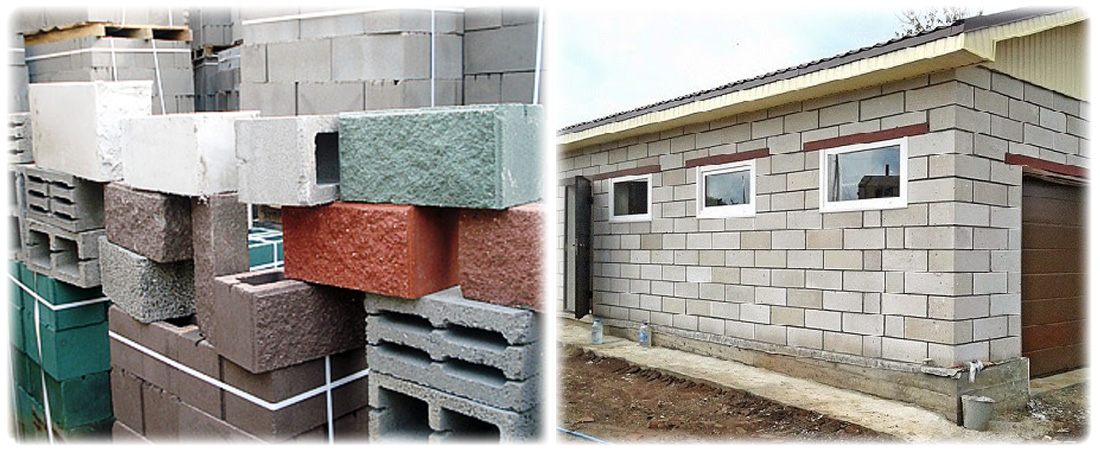
Method 2 - by area
The second way is to calculate the number of foam blocks of standard size for a building of 10x10x3 m with a wall thickness of 20, 30 or 40 cm for double-row laying. For this example, we put the block in one row with a wall thickness of 300 mm. The calculation technology is as follows:
- calculate the length of all walls, the outer perimeter - 4x10 = 40 m;
- determine the area of the walls - 40x3 = 120 m²;
- subtract from the area of the area of doorways and windows - to calculate it is not difficult, but take for example 10 m², total 110 m²;
- calculate the number of blocks per 1 m² - the area of one block = 0,12 m², total 1 / 0,12 = 8,33 pieces;
- how many blocks will go to the whole house, we learn, multiplying the total area by the area of one block, total - 110x8.33 = 916.3 pcs.
In this simple way, we learned that we need 917 foam blocks. To make corrections due to the difference in the size of the foam concrete of different manufacturers, we will use the above tables.
To calculate the amount that we will need to buy blocks, we also use a table that indicates the price per cubic meter.
Thus, we can safely calculate the amount that it will be necessary to build a summer residence or a country house made of foam concrete.
